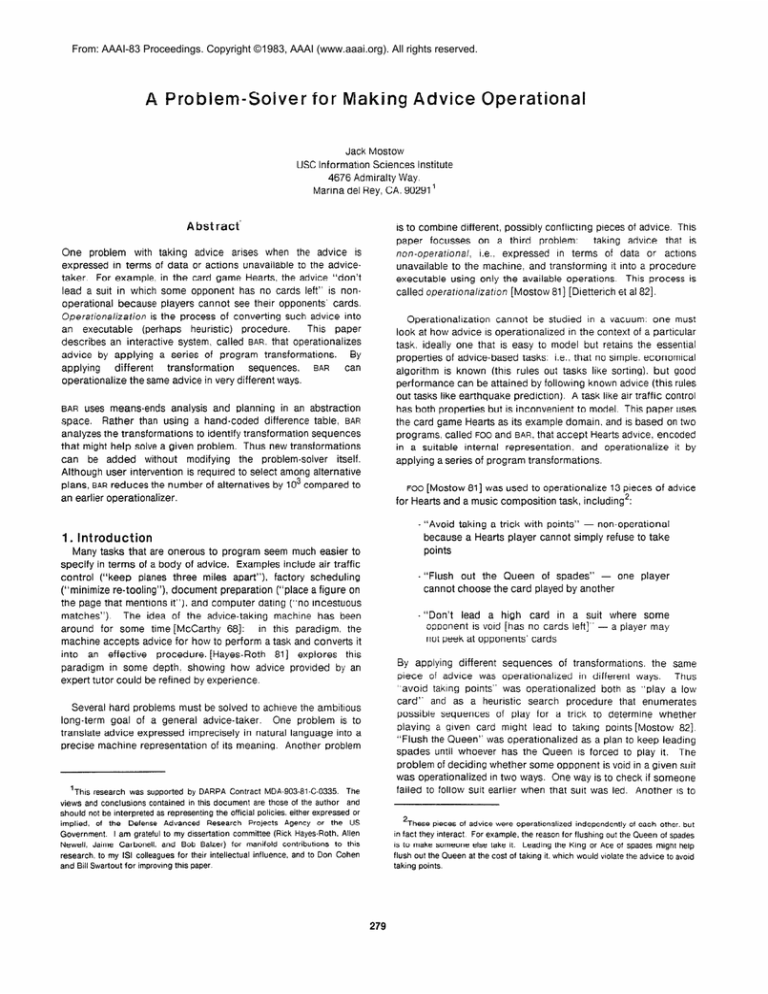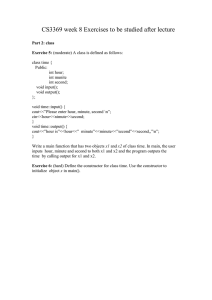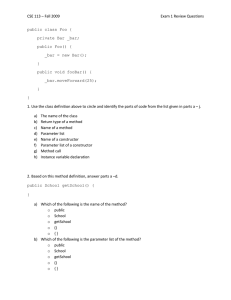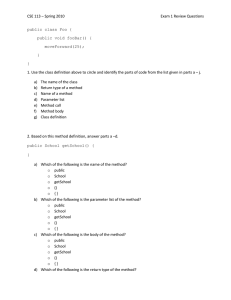
From: AAAI-83 Proceedings. Copyright ©1983, AAAI (www.aaai.org). All rights reserved.
A Problem-Solver
for Ma ing Advice
Operational
Jack Mostow
USC lnformatlon
Sciences
Institute
4676 Admiralty
Way.
Marina del Rey, CA. 90291’
Abstract’
is to combine
different,
possibly
conflicting
pieces of advice.
This
paper
focusses
on a third
problem:
taking
advice
that is
non-operational,
i.e.. expressed
In terms
of data or actlons
unavailable
to the machine,
and transforming
it into a procedure
executable
using only the available
operations
This process
is
called operational/zat/on
[Mostow
811 [Diettench
et al 821.
One
problem
with taking
advice
arises
when
the advice
is
expressed
in terms of data or actions
unavailable
to the advicetaker.
For example.
in the card game Hearts,
the advice
“don’t
lead a suit in which some opponent
has no cards left” is nonoperational
because
players
cannot
see their opponents’
cards.
Operationalization
is the process
of converting
such advice
into
an executable
(perhaps
heuristic)
procedure.
This
paper
describes
an interactive
system,
called BAR. that operationalizes
advice
by applying
a series
of program
transformations.
By
BAR
different
transformation
sequences,
can
awMw
operationalize
the same advice in very different
ways.
Operationalization
cannot
be studied
in a vacuum:
one must
look at how advice IS operationalrzed
in the context
of a particular
task. ideally one that is easy to model but retains the essential
properties
of advice-based
tasks.
i.e., that no simple. economlcal
algorithm
is known
(this rules out tasks
like sorting).
but good
performance
can be attained
by following
known advice (this rules
out tasks like earthquake
prediction).
A task like air traffic control
has both properties
but is inconvenient
to model. This paper uses
the card game Hearts as its example domain,
and is based on two
programs,
called FOO and BAR. that accept Hearts advice, encoded
in a suitable
internal
representation.
and operatlonalize
it by
applying
a series of program
transformations.
uses means-ends
analysis
and planning
in an abstraction
space.
Rather
than using
a hand-coded
difference
table, BAR
analyzes
the transformations
to identify transformation
sequences
that might help solve a given problem.
Thus new transformations
can
be added
without
modifying
the problem-solver
itself.
Although
user intervention
is required
to select among alternative
plans, BAR reduces
the number
of alternatives
by lo3 compared
to
an earlier operationalizer.
BAR
FOO [Mostow
811 was used to operationalize
13 pieces
for Hearts and a music composition
task, including*:
1. Int reduction
Many tasks that are onerous
to program
seem much easier to
specify
in terms
of a body of advice.
Examples
include air traffic
control
(“keep
planes three
miles apart”),
factory
scheduling
(“minimize
re-tooling”),
document
preparation
(“place
a figure on
the page that mentions
it”)* and computer
dating (*.no incestuous
matches”).
The idea of the advice-taking
machine
has been
around
for some
time [McCarthy
681:
in this paradigm,
the
machme
accepts
advice for how to perform
a task and converts
it
into
an effective
procedure.
[Hayes-Roth
811 explores
this
paradigm
in some depth.
showing
how advice
provided
by an
expert tutor could be refined by experience.
of advice
- “Avoid
because
points
taking a trick with points”
- non-operational
a Hearts player cannot simply refuse to take
- “Flush
cannot
out the Queen
choose
the card
- “Don’t
lead a high
opponent
is void [has
not peek at opponents’
of spades”
played by another
card
in
no cards
cards
one
player
a suit where
some
left]” - a player may
By applying
different
sequences
of transformations.
the same
piece
of advice
was operatronalized
in different
ways.
Thus
“avoid
taking points”
was operationalized
both as “play
a low
card”
and as a heuristic
search
procedure
that enumerates
possible
sequences
of play for a trick to determine
whether
playing
a given card mrght
lead to taking
points [Mostow
821.
“Flush
the Queen”
was operationallzed
as a plan to keep leading
spades
until whoever
has the Queen
IS forced
to play it. The
problem
of deciding
whether
some oppgnent
is void in a given suit
was operationalized
In two ways.
One way is to check if someone
failed to follow suit earlier when that suit was led Another
is to
Several hard problems
must be solved to achieve the ambitrous
long-term
goal of a general
advice-taker.
One problem
is to
translate
advice expressed
imprecisely
in natural language
into a
precise
machine
representation
of its meaning.
Another
problem
‘This research was supported by DARPA Contract MDA.903.81-C-0335.
The
views and conclusions
contained in this document are those of the author
and
should not be interpreted as representing the official policies. either expressed or
implied, of the Defense Advanced
Research
Projects
Agency or the US
Government.
I am grateful to my dissertation committee (Rick Hayes-Roth. Allen
Newell, Jaime Carbonell. and Bob Balzer) for manifold contributions
to this
research. to my ISI colleagues for their intellectual influence, and to Don Cohen
and Bill Swartout for improvmg this paper.
2
These preces of
in fact they interact
IS to make someone
flush out the Queen
taking points.
279
advice were operatlonallzed
independently of each other, but
For example, the reason for flushing out the Queen of spades
else take It. Leadmg the Kmg or Ace of spades might help
at the cost of takmg it. which would vlolate the advice to avoid
estimate
of cards
the probability
that
played in the suit.
someone
is void based
on the number
analysis
of knowledge
In BAR, different
kinds
represented
separately.
l-he examples
handled
by FOO averaged
60 steps in length.
At
each step. the decision
of which transformation
rule to apply and
which part of the advice to apply it to were made by hand.
Since
FOO had 230 general
transformation
rules. the branching
factor
was on the order
of lo3 to 104.
FOO’S successor.
BAR, helps
automate
the selection
of rule sequences,
reducing
the branching
factor to between
1 and 10 at each step. This lo3 improvement
is
achieved
by a combination
of means-ends
analysis
and abstract
planning.
BAR currently
has 60 rules and handles about half of the
13 examples
done using FOO.
2. A means-ends
3. Separation
approach
Both FOO and BAR incorporate
a problem
space [Newell
791
model
of operationalization,
whose
states are expressions
in a
LISP-like
language.
For example,
the expression
(Void p, so)
represents
the condition
“player
p, is void in suit so.”
The
operators
in this space are general transformation
rules.
BAR
formalizes
the
goal
structure
left implicit
in the
transformation
sequences
generated
using FOO. Goals
in the
operationalization
space (as opposed
to goals in the task domain
itself)
are expressed
in a pattern
language
containing
pattern
variables.
embedded
tests, segments,
Kleene star, and some other
constructs.
A problem
in this space
consists
of finding
a sequence
of
transformation
rules that rewrites
a given expression
to match a
given
pattern.
This is accomplished
by means-ends
analysis,
succinctly
described
in [Kant & Newell 821 as
the continual
comparison
of the current
state with
the desired
state (or its description);
the result of the
comparison
(a difference
or an opportunity)
is used to
select
the next operator
(to reduce
the difference
or
exploit the opportunity).
Differences
between
an expression
and
a pattern
include
mismatches
between
corresponding
symbols.
argument
transposition.
and so forth:
for a detailed
description
of BAR’S
pattern language
and the kinds of differences.
see [Mostow
831.
Two
kinds
of top-level
operationalization
problems
are
represented
in the pattern
language
by the tests @lsEvaluabie
and @lsAchievable.
The first represents
the goal of figuring
out
how to evaluate
a given expression
in terms
of observable
data.
The second
represents
the goal of finding
executable
actions
to
achieve
a given condition.
Subgoals
arise when a selected
transformation
rule does not apply to the current expression;
such
a subgoal
is represented
by a pattern language
description
of the
rule s left-hand
side.3
Many
means-ends
problem-solvers
GPS [Newell
601: the next two sections
have
describe
been
built since
the novel aspects
Of BAR.
3 BAR’S rules are encoded as procedures,
but BAR reasons about them using a
more convenient
pattern language representation.
The pattern language is
powerful enough to capture most if not all of each rule.
of knowledge
are
factored
apart
and
Task domain
knowledge
is encoded
as concept
definitions
and
features.
For example,
the predicate
Void(player.suit)
is defined
as (Not (Exists
card (Cards-in-hand
player)
(In-suit
card suit))).
and In-suit is marked
IsPredicate
and IsComputable
to represent
the fact that a Hearts
player
can test a given card to tell if it
belongs to a given suit. BAR currently
has 38 of FOO’S 112 concept
definitions.
Program
transformations
are encoded
as rules that do not
mention
the task domain
and may in fact be useful in more than
one domain.
BAR’S 60 rules
include
unfolding
and folding
definitions
[Darlington
761,
approximating
a predicate
P
probabilistically
as (High
(Pr P)) (“P is likely”),
and using a
combinatorial
formula to compute
the probability
that two subsets
randomly
chosen
from a given universe
will be disjoint.
Knowledge
about what is operational
is encoded
as general
facts. such as “A computable
function
of evaluabie
arguments
is
in
evaluable.”
represented
BAR
as
(@lsComputable
@ IsEvaluable’)
-matches+
@IsEvaluabie.
Finally.
knowledge
about
means-ends
problem-solving
is
encoded
procedurally.
Thanks
to this factoring
of knowledge.
domain
knowledge
and program
transformations
can be added to
BAR without
modifying
the problem-solving
procedure
itself.
Unlike GPS, BAR uses no built-in difference
table that indexes
directly
from differences
to operators.
Instead.
BAR analyzes
its
transformations
to determine
what kinds of differences
they might
help
reduce.
Some
of BAR’S knowledge
about
analyzing
transformations
is illustrated
below.
“If the left side
of a transformation
rule contains
an
argument
absent
from
the right side. the rule deletes
the
sub-expression
corresponding
to that
argument.”
For
example.
one such rule approximates
a binary
ordering
as the
corresponding
unary
predicate:
this rule is described
in the
pattern
language
as (@isOrdering
?x ?y) -+ (@IsPredicate
?x).
BAR deduces
that applying
this rule to an expression
has the effect
of deleting
the sub-expression
bound
to the pattern variable
?y.
This knowledge
is used in operationaiizing
the advice
“avold
taking
points”
as “play a low card”:
to evaluate
the expression
(Lower
(My-card)
(Card-played-by
?q)) (“my card is lower than the
card to be played
by player
?q”),
BAR decides
to eliminate
the
unevaluabie
second
argument
by approximating
the expression
as
(Low (My-card)).
“If the right side of a rule occurs
as a sub-pattern
of the
left
side,
the
rule
extracts
the
sub-expression
corresponding
to the sub-pattern.”
Such a rule is useful when
the current expression
does not match the current goal but one of
One such rule is described
in the
its sub-expressions
does.
pattern
language
as (@lsQuantifier
?x ?S [?P FreeOf ?x]) --, ?P.
This rule eliminates
a quantifier
when the quantified
predicate
is
independent
of (FreeOf)
the quantified
variable.
“If
the
both sides
of a rule have the
rule restructures
the expression
same top-most
symbol,
to which
it’s applied.”
Such
rules
are
expression
cannot
arguments
of the
arguments
(@ IsSymmetric
?x
5. A short
useful
when
the arguments
of the current
be rewritten
to match
the corresponding
current
goal.
One such rule transposes
the
relation:
of
a
symmetric
?y ?x).
?y) ---, (@lsSymmetric
This
“player
example
example
section
shows
how BAR operationalizes
the
p, is void in suit so.” [Mostow
831 presents
exhibiting
complexities
omitted here.
The initial problem
“If
the right
side
of a rule
is a constant,
the
rule
evaluates
the expression
to which
it’s applied.”
One such
rule recognizes
that a conjunction
contaming
a false term is false:
(And -. False --) -+ False.
BAR knows
that evaluation
IS one kind of
simplification.
and applies simplification
rules whenever
it can.
4. Abstract
> Goal:
Rewrite
is
po so) to match
BAR finds 6 abstract
rates them:
Plan
Pl (rated
-matches+
Disjoint
plans
@IsEvaluable
to get from
226):
Void to @IsEvaluable.
Void
-unfold-,
@IsEvaluable
Not
and
-fold+
plans
faces a combinatorially
explosive
problem
space. involving
transformation
sequences
dozens
of steps long, with several
rules
To cut down the combtnatorics.
BAR
applicable
at each step.
searches
in a simpler
abstracted
space
for plans to reduce
differences.
This restricts
the set of transformations
considered
to
those
that lead to a solution
in the abstracted
version
of the
problem
space.
A transformation
rule (L . ..) + (R . ..) or a fact (L
. . .) -matches+
(R . ..) in the original space IS abstracted
as L ---, R
in the sampler space.
To rewrite
an expression
(f ...) to match a
pattern
(g ...)s BAR searches
in the abstracted
space for paths of
the form f-rule+
. . . -rule+
g. Such paths are only a few steps
long. and are found
by depth-first
search.
Each such
path
constitutes
an abstract
plan for rewriting
(f . ..) to match (g . ..).
BAR
Plan
P2
-Fact44
When BAR finds only one
when it finds more than one,
as the number
of steps in the
subgoaling.
It then
asks
Alternatively
BAR can try them
present this tends to cause a
(rated
-91):
@IsEvaluable
Void
Plan
P3 (rated
-167):
-Rule227+
Implied-by
-Rule227+
Implied-
by
Void --Rule234-,
WasDuring
-Fact4+
@IsEvaluable
Plan
-Rule
P4
173+
(rated
True
-108):
-matches+
Plan
-Fact44
P5
(rated
@IsEvalua
-127):
ble
Void
-Rule1
93+
@I sEvalua
ble
Void
-Rule405+
In
High
Plan P6 (rated
-240):
Void --Rule3294
@IsQuantifier
-Rule1
55+
@IsPredicate
-Rule227+
Impliedby
-Fact4+
@IsEvaluable
In this example,
the user selects plan P5. In more detail, plan P5
In the course
of applying
such
a plan.
BAR must
solve
subproblems
that arise when a proposed
rule does not apply to
the current
expression.
It does so by recursively
invoking
itself
If the CAR
with the left side of the rule as the pattern to match
(top-level
function)
of the expression
matches
the CAR of the
pattern.
BAR
recursively
transforms
the arguments
of the
expression
to match the arguments
of the pattern:
if this fails, it
tries
to restructure
the
expression,
e.g.,
by transposing
arguments,
or looks for alternative
plans to get to the goal.
BAR’S
path-finder
avoids returning
more than one plan with a given first
step. so a successful
route to the goal may follow a plan part-way
and then switch to a new plan in mid-stream.
is
1 ! Approximate
predicate
pro babilistically
Rule405:
?P -+ (High (Pr ?P)).
2? Make
the
result
using
evaluable.
Plan P5 is rated
low because
Rule405
is marked
as an
approximating
method.
(Plan Pl leads to the same result by a
different
route; plans
P2 and P3 lead to alternative
solutions
described
later; P4 and P6 are dead ends.)
plan, it applies
it automatically,
but
it scores them based on such factors
plan and how many of them require
the user to select
among
them.
in order of decreasing
score, but at
runaway
search.
The ““’ denotes
the fact
producing
the transformation
(Void
P, so) + (High
that step
(Pr (Void
1
can be applied
Immediately.
p, so)))
The “?” denotes
the fact that step 2 requires
some subgoaling.
The problem
is that although
the predicate
High IS marked
IsComputable,
there is no general definition
for Pr. This problem
leads to the subgoal
Of course,
an abstract
plan may fail; this occurs
when the
current
expression
cannot
be transformed
to match the next step
in the plan.
To reduce
the incidence
of plan failure. BAR uses a
simple form of learning by experience:
it records
how often it tries
to match the left side of each rule, and how often it succeeds.
One result discovered
by this simple tuning mechanism
is that it is
easier to make an expression
runtime-evaluable,
i.e., to match the
pattern
@IsEvaluable,
than to actually
evaluate
it, i.e., to match
@IsConstant.
This knowledge
influences
the order in which
the
abstracted
space is searched.
in the hope that of all the plans that
start the same way. BAR will find tne one most likely to succeed.
The
means
spaces
depths
(Void
condition
a longer
> Goal:
Rewrite
BAR
without
(Pr (Void
finds one
asking:
Use formula
randomly
chosen
(Pr (Disjoint
(SetOf
- (Pr-disjoint-formula
(# (SetOf
(# (SetOf
(# ?U))
2.1?
combmation
of abstract
planning
and recursive
descent
that
BAR
plans
tn a hierarchy
of
abstraction
[Sacerdoti
741 corresponding
to successive
nesting
of sub.expressi0n.s.
281
p, so)) to match
plan to get from
@IsEvaluable
Pr to @IsEvaluable
for probability
that two
subsets
of ?U will be disjoint:
x ?U ?P) (SetOf
y ?U ?a)))
x ?U ?P))
y ?U ?a))
and
tries
it
2.2?
Make
To apply
Disjoint:
arguments
step
> Goal:
Rewrite
(Disjoint
2.1,
of formula
must
BAR
first
Void
Void
into
instance
= (Not
in terms
to Disjoint:
Make
x Sl
of formula
evaluable.
is evaluable
except for the predicate
Has.
BAR finds 3 plans
for evaluating
the first
the user accepts the top-ranked
one, and
2.2.1!
Fold into instance
of computable
(# (SetOf
x (Cards)
(Has p x1)) (Number-cards-in-hand
p3
the user accepts
This completes
of
(Exists
arguments
The resulting
expression
which is not computable.
argument
of the formula,
BAR carries
it out:
of
?y ?U ?a))
2.1 .I! Unfold
definition
of Void:
(Void po so) (Not (Exists
c (Cards-in-hand
po) (In-suit
2.1.2?
Fold
Disjoint(Sl,S2)
2.2?
reformulate
(Void po so) to match
(SetOf
?x ?U ?P) (SetOf
BAR finds 5 plans to get from
the top-ranked
one:
evaluable.
the original
function:
plan:
2! Expression
is now evaluable:
(High (Pr-disjoint-formula
(Number-cards-in-hand
po)
(# (SetOf
y (Cards)
(In-suit
y so)))
(# (Cards))))
c so)))
(In x S2)))
halts, having achieved
its ortginal goal of operatlonalizing
the
condition
“player
p, is void in suit so” by reformulating
it as there
being a high probability
that player pp’s hand is disjoint from suit
so, based on the size of the hand. A more accurate
estimate
was
derived
in FOO by restricting
the universe
to the set of unplayed
cards, but this refinement
is omitted here for brevity
BAR
To do step
membership:
> Goal:
Rewrite
finds
top-ranKed
BAR
2.1.2,
(In-suit
4 plans
one:
2.1.2.1!
BAR
must
reformulate
c so) to match
to get from
Pc -
in terms
of set
(In x S2)
In-suit
(In c (SetOf
In-suit
to In. and the user accepts
y S Py)), where
c has type
the
BAR’S
generality
is illustrated
by the
fact
that
it can
operationalize
(Void p, so) in very different
ways by following
different
plans.
Plan P2 exploits
the assumption
that player
p,
plays legally, and leads to the Inference
that a player who fails to
follow
suit must be void.
The main subproblem
consists
of
inferring
that the condition
(Void p, so) is rmplred by the axrom
(Legal p (Card-played-by
p)) when (Suit-led)
= so and (Not (In-suit
(Card-played-by
pa) so)). Plan P3 is based on remembering
past
events,
and leads to the inference
that a player who was void
earlier in the round must still be void now. The key subproblem
is
to prove that a player who is void remains
void.
This is done by
showing
that becoming
unvoid would
require
obtaining
a card,
which cannot occur during the course of play.
S
This “jittering”
rule [Fickas
SO] rewrites
an arbitrary
predicate
P
on an object
c in terms
of set membership:
c satisfies
P if c
belongs to the set of things that satisfy P. Here this rule produces
the transformation
(In-suit
This
enables
c soI -
(In c (SetOf
the previous
y (Cards)
(In-suit
plan to be completed:
2.1.2!
Fold into instance
of Disjoint:
(Not (Exists
c (Cards-in-hand
po)
(In c (SetOf
y (Cards)
(In-suit
- (Disjoint
(Cards-in-hand
po)
(SetOf
To match
argument
> Goal:
Rewrite
BAR
applies
finds
it:
y (Cards)
(In-suit
(Cards-in-hand
2.1.3!
Unfold
(Cards-in-hand
The disjoint-subsets
plan
disjoint
po) to match
to get
definition:
po) -
y so)))))
These solutions
can be combined
to produce
the solution
“a
player who failed to follow suit earlier is definitely
void: otherwise,
if few cards are left, the player is likely to be void.”
The order of
composition
is based on the fact that plan P2 leads to a correct
semi-decision
procedure
whose
usefulness
is extended
by P3,
while Pl produces
a total but approximate
decision
procedure.
BAR lacks
an explicit
understanding
of these factors.
and does not
combine
solutions.
y so)))
the left side of the
must be rewritten:
one
y so)))
from
subsets
(SetOf
Cards-in-hand
(SetOf
x (Cards)
rule can now
be applied:
rule.
the
x ?U ?P)
to SetOf
(Has
frrst
and
6. Improvements
to the problem-solver
The construction
of a general
advice-taker
remains
a long-term
goal posing some difficult
problems
not addressed
here. notably
In addition.
BAR inherits
integrating
multiple
pieces
of advice.
many limitations
of ~00, such as a far-from-complete
set of
transformations.
However,
experience
with BAR has exposed
several more specific
problems
worth mentioning
here.
p. x))
2.1! Use probability
formula
for disjoint
subsets:
(High (Pr (Disjoint
(SetOf
x (Cards)
(Has p, x))
(SetOf
y (Cards)
(In-suit
y so)))))
- (High (Pr-disjoint-formula
(# (SetOf
x (Cards)
(Has p, x1))
(# (SetOf
y (Cards)
(In-suit
y so)j)
First, BAR uses a very simple all-or-none
model of operationality:
either an expression
can be evaluated
or it cannot.
This model
ignores such factors
as the cost of evaluation,
the fact that some
expressions
can be evaluated
sometrmes
but not always. and the
semantrc
relationshrp
between
the ongrnal advice and tts (perhaps
heuristically)
operationalized
form.
(# (Ca rds))))
282
process
developing
Since
BAR does
not model the relative
quality
of alternative
solutions.
it cannot
explicitly
model the notion of refining a crude
solution
into an improved
one.
The refinement
paradigm
was
evident
in more than one example
generated
using ~00. especially
in the synthesis
of a heuristic
search
procedure
by applying
optimizing
transformations
to
an
initial
generate-and-test
search
[Mostow
821. A simple
way to incorporate
this into the
means-ends
analysis
paradigm
is to treat refinement
somewhat
like simplification:
designate
certain
rules as refinement
rules and
automatically
include
them in the set of options
whenever
they
appear
applicable
to the current
expression
(at the cost
of
increasing
the branching
factor).
Of course the decision
whether
to actually
apply such a rule depends
on its relative costs
and
benefits
rn the case at hand.
could
significantly
software
[Fickas
enhance
821.
human
productivity
in
References
[Darlington
761 J. Darlmgton
and R. M. Burstall.
“A system which
automatically
improves
programs,”
Acta lnformatxa
6. 1976,
41-60.
[Dietterich
et al 821 T. G. Diettench.
Bob London. K. Clarkson.
and
G. Dromey,
“Mostow’s
Operatronalizer.”
in P. R. Cohen and
E. A. Feigenbaum,
Volume 3 (eds.), Handbook
of Artificial
Intelligence,
Stanford
Computer
Science
Department,
Stanford,
CA, 1982. In section on Learning
and Inductive
Inference,
available
as STAN-CS-82.913/HPP-82.10.
[Feather
831 M. S. Feather,
In preparation.
To make operationalization
totally
automatic.
BAR’S problem.
solver must be substantially
Improved.
One problem is that BAR’S
depth-first
search
strategy
is too sensitive
to selecting
the wrong
plan, which causes
exhaustive
exploration
of that branch
of the
search
tree.
A more cautious
breadth-first
strategy
might avoid
this pitfall. but implementing
it would
be complicated
by the
recursive
nature of the problem-solver.
Closed
System
Specifications,
1983.
[Fickas
801 S. Fickas,
“Automatic
goal-directed
program
transformation,”
in AAA180, pp. 68-70. American
Association
for Artificial
Intelligence,
Stanford
University,
1980.
[Fickas 821 S. Fickas, Automating
fhe Transformational
Developmen?
of Software,
Ph.D. thesis, University
of
California
at Irvine, 1982.
[Hayes-Roth
811 F. Hayes-Roth.
P. Klahr. and D.
“Advice
taking and knowledge
refinement.
of skill acquisition
” in J. A. Anderson
(ed.).
and their Acquisif/on,
pp. 231-253.
Erlbaum.
The current
plan-rating
scheme
suffers from the horizon
effect
in that problems
pushed
down to a lower level are ignored.
For
example,
plan Pl receives
an unrealistically
high rating because
it
ignores
the problem
of evaluating
the arguments
of Disjoint.
The
ratings
could
be improved
by identifying
obstacles
to the
evaluation
of an expression
and estimating
the difficulty
of
eliminating
each
one.
Identifying
the
obstacles
seems
straightforward,
but it is not clear how to estimate
their difficulty
without
actually solving them.
[Kant
& Newell
technques
821 E. Kant and A Newell.
Information
solving
Carnegie-Mellon
Science
Department
Technical
November
1982. To appear in
for the design
University
Computer
Report CMU-CS-82-145.
Problem
J. Mostow.
an iterative view
Cogn/trve
Skills
1981
Processing
of algorithms,
and
Management.
[McCarthy
681 J. McCarthy,
“The advice taker,” in M. Minsky
(ed.). Semantic
lnformafion
Processing,
pp, 403-410,
MIT
Press. Cambridge.
MA, 1968.
A fundamental
problem
with the planner
is caused
by using
CAR as the abstraction
function.
This works fine on instances
of
highly specific
functions,
like Void, but loses too much information
when applied to quantifiers
like Exists, logical connectives
like Not
and And, and general
functions
like In.
This results
in the
generation
of silly plans.
This problem
might be ameliorated
by
designing
a more discriminating
abstraction
function.
Some such
improvement
is essential
to constrain
the generation
of abstract
plans; although
the current
branching
factor
of under 10 is a vast
improvement
over
FOO,
the
length
of the
transformation
sequences
(sometimes
over 100) implies that total automation
will
require an average branching
factor very close to 1.
[Mostow
791 D.
heuristics:
in IJCAI-5,
[Mostow
811 D.
J. Mostow and F. Hayes-Roth.
“Operationaliztng
some Al methods
for assisting
Al programming.”
pp. 601-609, Tokyo. Japan. 1979.
J. Mostow,
Mechanical
Transformaf/on
of Task
Heurlsfxs
into Operational
Procedures.
Ph.D. thesis.
Carnegie-Mellon
University.
1981. Technical
Report CMUCS-81 - 113.
[Mostow
821 D. J. Mostow,
“Learning
by being told: Machine
transformation
of advice into a heuristic
search procedure,”
in J. G. Carbonell.
R. S. Michalski,
and T. M. Mitchell (eds.),
Machine
Learning.
Palo Alto, CA: Tioga Publishing
Company,
1982.
“Operationalizing
advice:
a problem[Mostow
831 J. Mostow.
solving model.”
in Proceedings
of the Infernational
Machine
Learning
Workshop,
University
of Illinois. June 1983.
7. Conclusion
BAR was implemented
to make explicit
the goal structure
left
implicit in FOO, and in this it has largely succeeded.
Although
it
does not totally automate
the selection
of what operators
to apply.
it has reduced
the branching
factor by a factor
of 103. without
even counting
the effect of plan scoring.
It has been used to solve
about
half the examples
done with FOO. and has clarified
the
improvements
needed
to handle some
of the others:
a more
sophisticated
control
structure
and model of operatronality
that
make explicit the heuristic
nature of operationalization.
[Newell
601 A. Newell, J. Shaw, H. Simon, “Report
on a general
problem-solving
program
for a computer,”
in Proceedings
the International
Conference
on Information
Processing,
pp. 256-264,
UNESCO,
Paris, 1960.
In short,
BAR should
be viewed as a problem-solving
model
rather than as a practical
automatic
tool, and the broad scope of
the operationalization
problem
makes this likely to remain the case
for Improved
versions
of BAR in the forseeable
future.
However.
technrques
developed
in BAR may soon find practical
use in the
area
of program
transformation.
An especially
promising
applicatron
is the problem
of reformulating
system
components
described
in the Gist specification
language
[Feather
831 in terms
and
operations
available
to
their
of
the
data
implementations
[Mostow
831.
Even partial automation
of this
[Newell
791 A. Newell,
processes:
Reasoning,
problem
solving and decision
the problem
space as a fundamental
category,
Carnegie-Mellon
University
Pittsburgh,
PA, Technical
Computer
Science
Report, June 1979.
Department,
[Sacerdoti
741 E. D. Sacerdoti,
“Planning
in a hierarchy
of
abstraction
spaces,”
Artificial
Intelligence
5, 1974, 115- 135.
283
of





